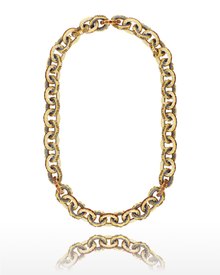
A bead is a small, decorative object that is formed in a variety of shapes and sizes of a material such as stone, bone, shell, glass, plastic, wood, or pearl and with a small hole for threading or stringing. Beads range in size from under 1 millimeter (0.039 in) to over 1 centimeter (0.39 in) in diameter.

Jewellery consists of decorative items worn for personal adornment, such as brooches, rings, necklaces, earrings, pendants, bracelets, and cufflinks. Jewellery may be attached to the body or the clothes. From a western perspective, the term is restricted to durable ornaments, excluding flowers for example. For many centuries metal such as gold often combined with gemstones, has been the normal material for jewellery, but other materials such as glass, shells and other plant materials may be used.

A torc, also spelled torq or torque, is a large rigid or stiff neck ring in metal, made either as a single piece or from strands twisted together. The great majority are open at the front, although some have hook and ring closures and a few have mortice and tenon locking catches to close them. Many seem designed for near-permanent wear and would have been difficult to remove.

A necklace is an article of jewellery that is worn around the neck. Necklaces may have been one of the earliest types of adornment worn by humans. They often serve ceremonial, religious, magical, or funerary purposes and are also used as symbols of wealth and status, given that they are commonly made of precious metals and stones.

A fastener or fastening is a hardware device that mechanically joins or affixes two or more objects together. In general, fasteners are used to create non-permanent joints; that is, joints that can be removed or dismantled without damaging the joining components. Steel fasteners are usually made of stainless steel, carbon steel, or alloy steel.

An anklet, also called ankle chain, ankle bracelet or ankle string, is an ornament worn around the ankle. Ancient egyptian women were the first to were anklets according to history. Barefoot anklets and toe rings and also have been worn by girls and women in Indus Valley, in South Asia where it is commonly known as pattilu, payal, golusu and sometimes as nupur. In the United States both casual and more formal anklets became fashionable from the 1930s to the late–20th century. While in Western popular culture both younger men and women may wear casual leather anklets, they are popular among barefoot women. Formal anklets are used by some women as fashion jewellery. Anklets are an important piece of jewellery in Indian marriages, worn along with saris.

Cufflinks are items of jewelry that are used to secure the cuffs of dress shirts. Cufflinks can be manufactured from a variety of different materials, such as glass, stone, leather, metal, precious metal or combinations of these. Securing of the cufflinks is usually achieved via toggles or reverses based on the design of the front section, which can be folded into position. There are also variants with chains or a rigid, bent rear section. The front sections of the cufflinks can be decorated with gemstones, inlays, inset material or enamel and designed in two or three-dimensional forms.

Filigree is a form of intricate metalwork used in jewellery and other small forms of metalwork.

Jewellery findings are the parts used to join jewellery components together to form a completed article.
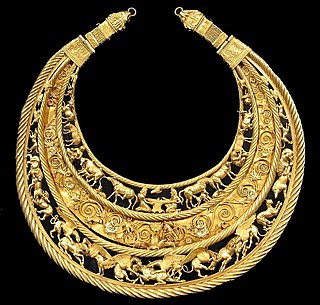
Jewellery as an art form originated as an expression of human culture. Body ornamentation, one purpose of jewellery, has been known since at least the Stone Age. The history of jewellery in Ukraine reflects the influence of many cultures and peoples who have occupied the territory in the past and present.

A fibula is a brooch or pin for fastening garments, typically at the right shoulder. The fibula developed in a variety of shapes, but all were based on the safety-pin principle. Unlike most modern brooches, fibulae were not only decorative; they originally served a practical function: to fasten clothing for both sexes, such as dresses and cloaks.

The mouthpiece is the part of a horse's bit that goes into the mouth of a horse, resting on the bars of the mouth in the sensitive interdental space where there are no teeth. The mouthpiece is possibly the most important determinant in the severity and action of the bit. Some mouthpieces are not allowed in dressage competition.

Jewelry wire is wire, usually copper, brass, nickel, aluminium, silver, or gold, used in jewelry making.

A chain is a serial assembly of connected pieces, called links, typically made of metal, with an overall character similar to that of a rope in that it is flexible and curved in compression but linear, rigid, and load-bearing in tension. A chain may consist of two or more links. Chains can be classified by their design, which can be dictated by their use:
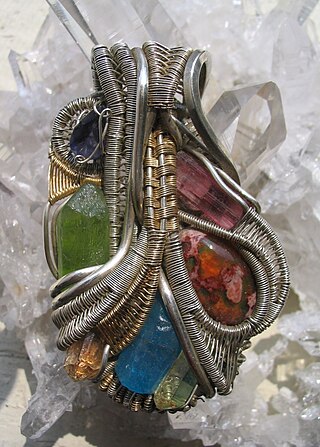
Wire wrapping is one of the oldest techniques for making handmade jewelry. This technique is done with jewelry wire and findings similar to wire to make components. Wire components are then connected to one another using mechanical techniques with no soldering or heating of the wire. Frequently, in this approach, a wire is bent into a loop or other decorative shape and then the wire is wrapped around itself to finish the wire component. This makes the loop or decorative shape permanent. The technique of wrapping wire around itself gives this craft its name of wire wrapping.
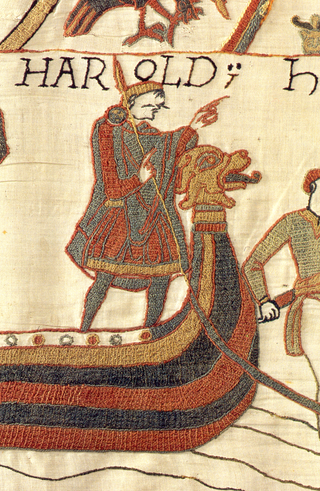
Anglo-Saxon dress refers to the clothing and accessories worn by the Anglo-Saxons from the middle of the second century to the eleventh century. Archaeological finds in Anglo-Saxon cemeteries have provided the best source of information on Anglo-Saxon costume. It is possible to reconstruct Anglo-Saxon dress using archaeological evidence combined with Anglo-Saxon and European art, writing and literature of the period. Archaeological finds have both supported and contradicted the characteristic Anglo-Saxon costume as illustrated and described by these contemporary sources.
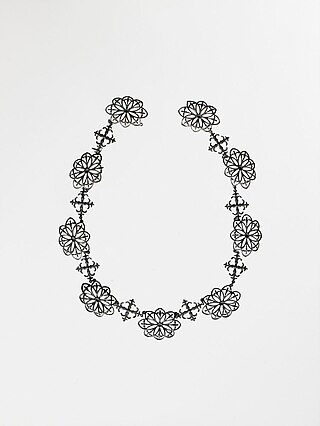
Berlin iron jewellery refers to articles of cast-iron jewellery that were made during the early 19th century in Germany.
A glossary of terms used in glass art
John Donald was a British jeweller and designer whose work was strongly identified in the 1960s and 1970s in London. Princess Margaret and the Queen Mother purchased works by John Donald in the 1960s, having been introduced to him by Antony Armstrong-Jones, 1st Earl of Snowdon.

The dragonesque brooch is a distinctive type of Romano-British brooch made in Roman Britain between about 75 and 175 AD. They have been found in graves and elsewhere, in recent years especially by metal-detectors, and were evidently a fairly affordable style; over 200 examples are now known. The name comes from a supposed resemblance to a dragon, but Catherine Johns suggests that if any real animal was intended to be represented, the hare may be the most likely candidate.


